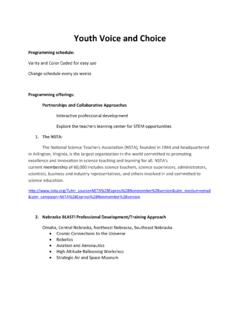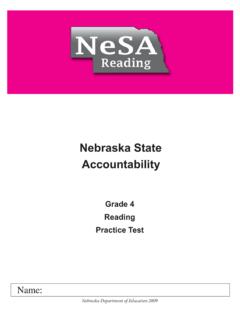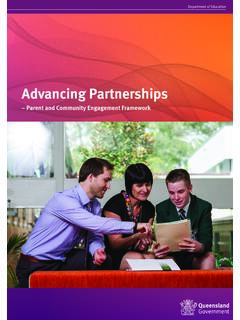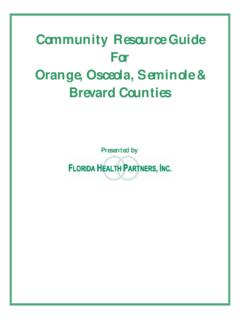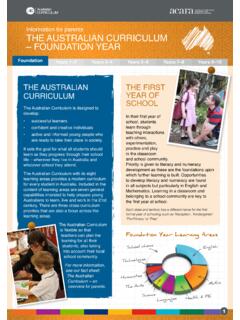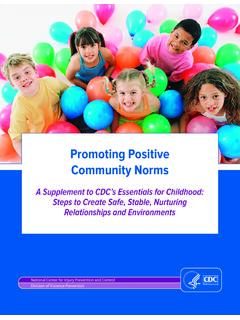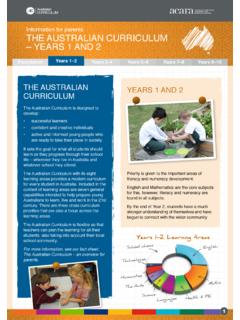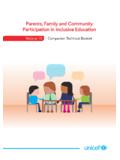Transcription of Partnerships with Families and Communities - Nebraska
1 The Primary Program: Growing and Learning in the Heartland Partnerships with Families and Communities 83 How to Build Partnerships that Work: Davies Three Basic Principles Successful Partnerships are based on reciprocity. This means that all those involved in the partnership school, family, and community have overlapping responsibilities for children s learning. Each needs the help of the others in formal and informal structures. Developing effective Partnerships is a democratic process. Partnerships should recognize the different interests, races, religions, and educational status of its participants, and should be prepared to resolve conflicts through the democratic processes of mediation, negotiation, and compromise.
2 Effective Partnerships provide a variety of opportunities. A comprehensive program of Partnerships will include such elements as parent education, family support, volunteer activities, good communication, opportunities to participate in decision making, and strategies that foster children s learning at home and in the community . From: Davies, D. (2000). How to build Partnerships that work. Principal 80(1) Partnerships with Families and Communities Creating effective Partnerships between schools, parents , and Communities isn t just a nice idea. It s a necessity.
3 Davies, 2000 Partnerships in education build bridges between Families , Communities , and schools. As children interact with the people, places and things associated with the family, the immediate community , and beyond, they extend their horizons to develop the attitudes, skills, and knowledge they need to become effective citizens.
4 In order to provide the best possible education, schools must partner with Families and Communities . True Partnerships are based on mutual respect. Teachers respect and value parents knowledge and insights about their children. parents respect and value teachers knowledge and insights about the learning process and understanding children s educational needs. In a school-family- community partnership, all members of the community recognize changing family needs in order to raise children in an environment that provides the conditions for health, safety, and learning.
5 Every adult has a stake in the education and welfare of children. It is essential for adults to build bridges in order to work together so children are healthy and safe. It is important to provide children with a rich and supportive learning environment. Schools, Families , and community members must recognize these common goals and work together for the sake of children. The Primary Program: Growing and Learning in the Heartland Partnerships with Families and Communities 84 School-Family- community Partnerships A family-centered perspective is essential to the success of the school-family- community partnership.
6 The importance of involving parents in the education of their children cannot be overestimated. Teachers must always remember that parents are the child s first teachers and that a partnership between home and school benefits children, Families , and teachers alike. The unique cultural, ethnic, and language aspects of each community , as well as its rural or urban nature, offer both opportunities and challenges for establishing responsive Partnerships . Teachers and administrators must not assume that a lack of parental involvement means non-caring.
7 They must work to understand the barriers that keep some parents from being more involved in their child s education. Family-friendly schools must reach out to parents and the community to develop multiple ways to work together so everyone benefits and feels valued. Davies (2000) offers five recommendations to help principals build Partnerships with Families and the community : Five Recommendations Look first to your teachers. Teachers are the most important link in the success of any partnership effort. They can provide guidance for Families on setting realistic expectations, monitoring and helping with homework.
8 And selecting appropriate books and learning materials. Unfortunately, many Partnerships are developed with little or no teacher input. Instead, teachers are told to just do it, which can doom the effort from the start. Principals should seek teacher input and encourage teachers to develop their own learn-at-home materials for parents to use. Because parent-teacher conferences have been proven to be an effective way to build trust and cooperation among the partners, they should be held at least twice a year, last at least a half-hour, and focus on student work.
9 The fleeting teacher-parent conferences traditionally held during open houses don t contribute much. Make your school family-friendly. There is good evidence that schools that are friendly and welcoming to family members have an easier time creating successful partnership programs. Here are some ways schools can create a family-friendly environment: Establish a parent or family center within the school Offer good, frequent, and user-friendly communication Provide good after-school programs that involve parents and community organizations Organize social activities for teachers and Families Provide parent education and family literacy programs Have programs that link Families to needed health and social services Obviously, these programs will be more successful if they are accompanied by a friendly and respectful attitude that can be communicated in many different ways.
10 Smiles, pleasant greetings, signs and decorations that recognize the different languages and cultures in the community ; and a clean, bright, and inviting ambiance. The Primary Program: Growing and Learning in the Heartland Partnerships with Families and Communities 85 Reach into your community . If educational equity is the goal, then school and parent leaders must reach out to those in the community who are considered hard to reach. Here are three practical ideas suggestions: Train volunteer parents and community residents to visit Families at home, where they can provide information about school programs and services, offer ideas about how to help children study at home, answer questions, and respond to requests.

